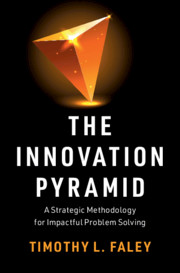Book contents
- The Innovation Pyramid
- The Innovation Pyramid
- Copyright page
- Dedication
- Contents
- Figures
- 1 Introduction
- Part I Innovation Design and Execution
- Part II The Diverge–Organize–Converge Process
- 8 Diverge–Organize–Converge Process Overview
- 9 Diverge
- 10 Organize
- 11 Converge
- 12 Book Summary
- Book part
- Bibliography
- Index
9 - Diverge
from Part II - The Diverge–Organize–Converge Process
Published online by Cambridge University Press: 30 December 2020
- The Innovation Pyramid
- The Innovation Pyramid
- Copyright page
- Dedication
- Contents
- Figures
- 1 Introduction
- Part I Innovation Design and Execution
- Part II The Diverge–Organize–Converge Process
- 8 Diverge–Organize–Converge Process Overview
- 9 Diverge
- 10 Organize
- 11 Converge
- 12 Book Summary
- Book part
- Bibliography
- Index
Summary
Divergent thinking is the first of three essential steps in completing the non-linear DOC Process. Like all DOC Process steps, divergent thinking applies to both the problem and solution spaces. It simply requires different techniques when seeking to identify a root-cause problem versus attempting to come up with a new impactful problem-solving approach.
Identifying root cause issues begins with broadening our purview to ensure we are not overlooking the disease by focusing too closely on its symptoms. Divergence occurs as we zoom in from this broad purview; identifying factors or causes of the identified zoomed-out General Problem, then factors of the identified factors, then causes of the sub-factors, and so on, until the root-cause level is reached.
Divergent thinking for solutions occurs on several perspective levels: feature, function and system. In addition to ideating new and improved features of existing solutions, substitute solutions should be considered. Potential substitutes perform the same function as current solutions, but do so in a very different way. New technology is often the enabler of substitute products. System level thinking diverges solution ideas by strengthening or streamlining system connections or linkages at the broadest purview.
Keywords
- Type
- Chapter
- Information
- The Innovation PyramidA Strategic Methodology for Impactful Problem Solving, pp. 170 - 186Publisher: Cambridge University PressPrint publication year: 2021



